International Management Report: Analyzing Lee's Cultural Adjustment
VerifiedAdded on 2020/03/04
|11
|2554
|53
Report
AI Summary
This report examines the challenges faced by Lee, an employee who transitioned from Australia to Korea, highlighting the impact of cultural differences in international management. The report utilizes Hofstede's cultural dimensions to explain Lee's experiences, focusing on individualism versus collectivism, indulgence versus restraint, power distance, masculinity versus femininity, uncertainty avoidance, and long-term orientation. It analyzes how these dimensions contribute to workplace dynamics and employee behavior. The report further suggests strategies for Lee to adapt to the Korean work environment and provides recommendations for the Korean manager to effectively support individualistic employees. The analysis emphasizes the importance of understanding and respecting cultural differences for successful international management and employee integration, offering practical insights for both employees and managers navigating diverse cultural contexts.
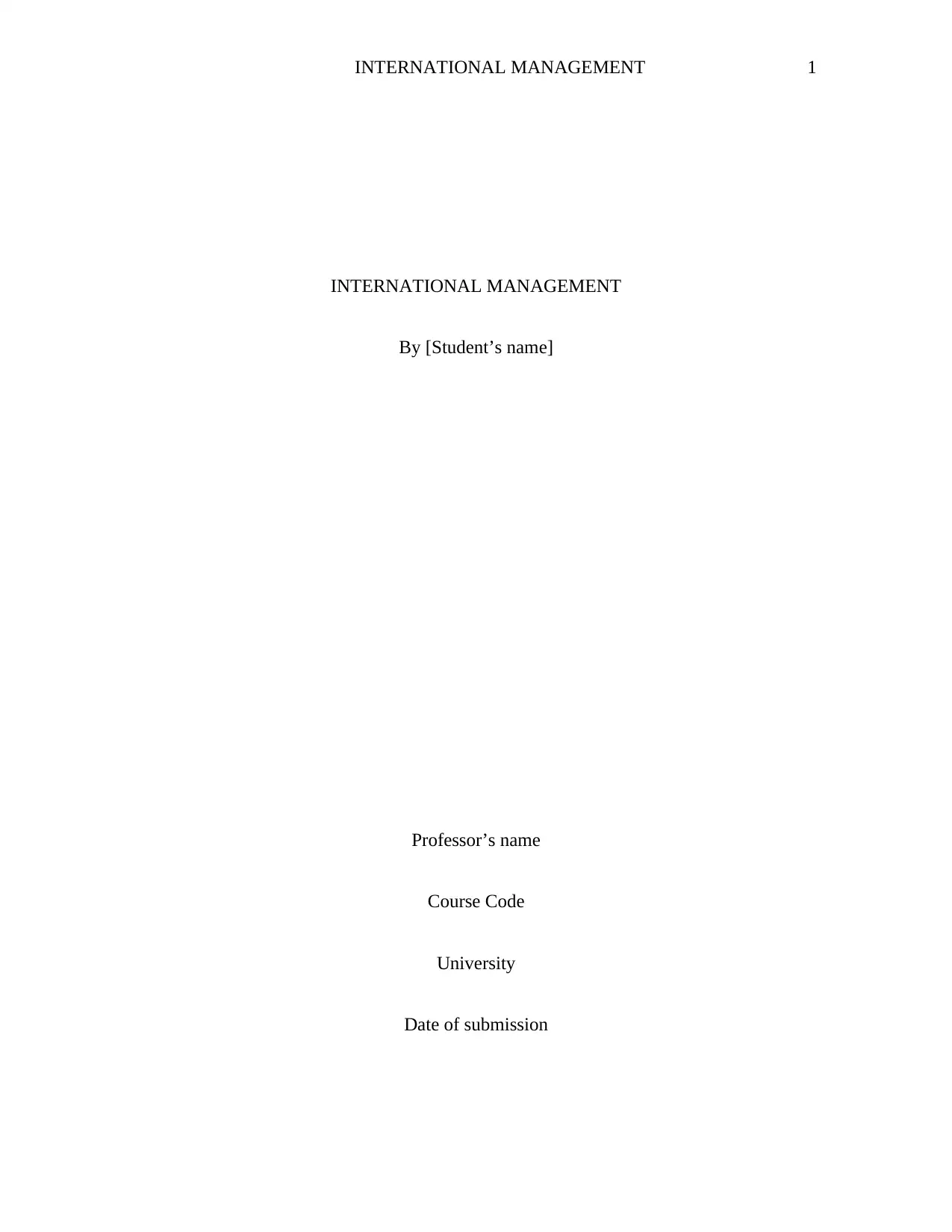
INTERNATIONAL MANAGEMENT 1
INTERNATIONAL MANAGEMENT
By [Student’s name]
Professor’s name
Course Code
University
Date of submission
INTERNATIONAL MANAGEMENT
By [Student’s name]
Professor’s name
Course Code
University
Date of submission
Paraphrase This Document
Need a fresh take? Get an instant paraphrase of this document with our AI Paraphraser
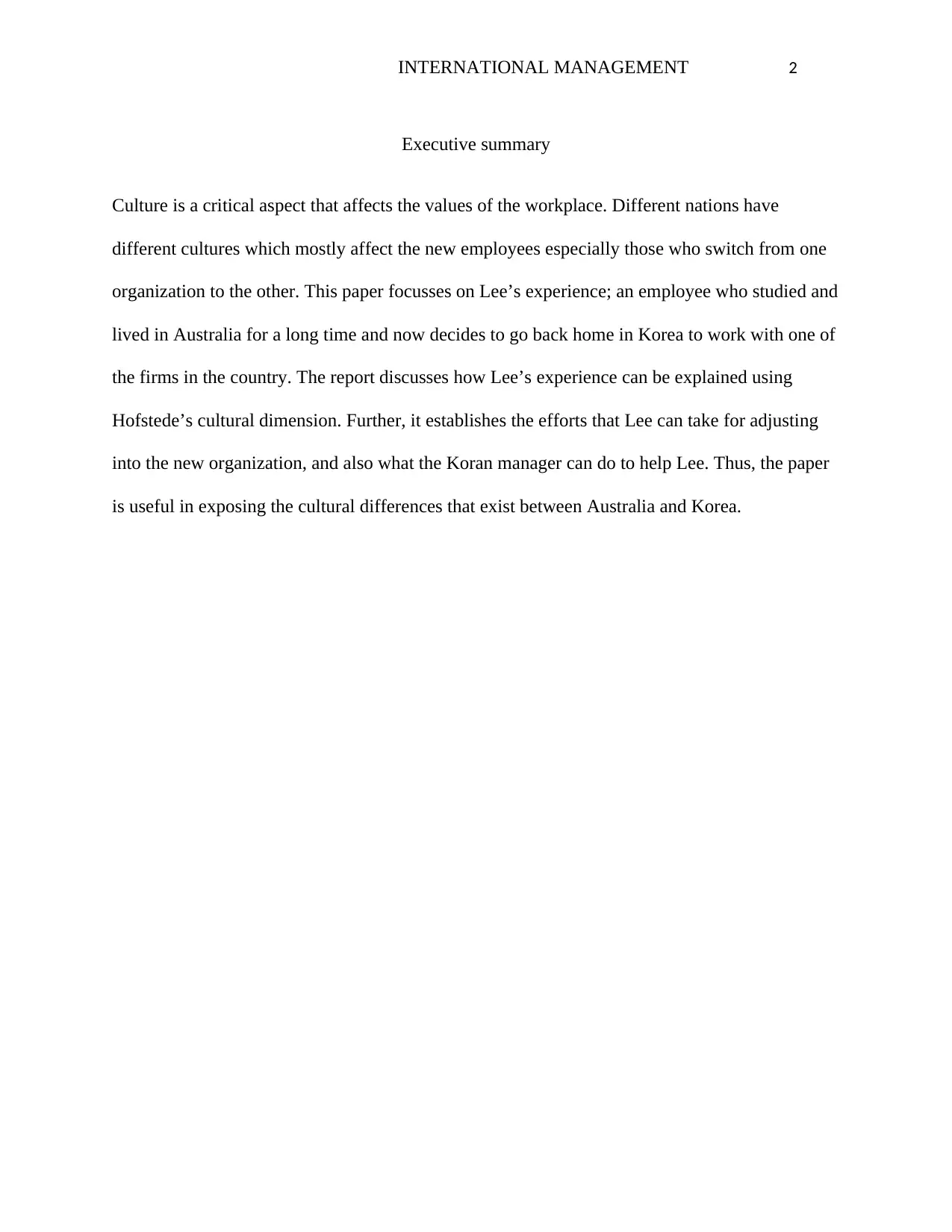
INTERNATIONAL MANAGEMENT 2
Executive summary
Culture is a critical aspect that affects the values of the workplace. Different nations have
different cultures which mostly affect the new employees especially those who switch from one
organization to the other. This paper focusses on Lee’s experience; an employee who studied and
lived in Australia for a long time and now decides to go back home in Korea to work with one of
the firms in the country. The report discusses how Lee’s experience can be explained using
Hofstede’s cultural dimension. Further, it establishes the efforts that Lee can take for adjusting
into the new organization, and also what the Koran manager can do to help Lee. Thus, the paper
is useful in exposing the cultural differences that exist between Australia and Korea.
Executive summary
Culture is a critical aspect that affects the values of the workplace. Different nations have
different cultures which mostly affect the new employees especially those who switch from one
organization to the other. This paper focusses on Lee’s experience; an employee who studied and
lived in Australia for a long time and now decides to go back home in Korea to work with one of
the firms in the country. The report discusses how Lee’s experience can be explained using
Hofstede’s cultural dimension. Further, it establishes the efforts that Lee can take for adjusting
into the new organization, and also what the Koran manager can do to help Lee. Thus, the paper
is useful in exposing the cultural differences that exist between Australia and Korea.
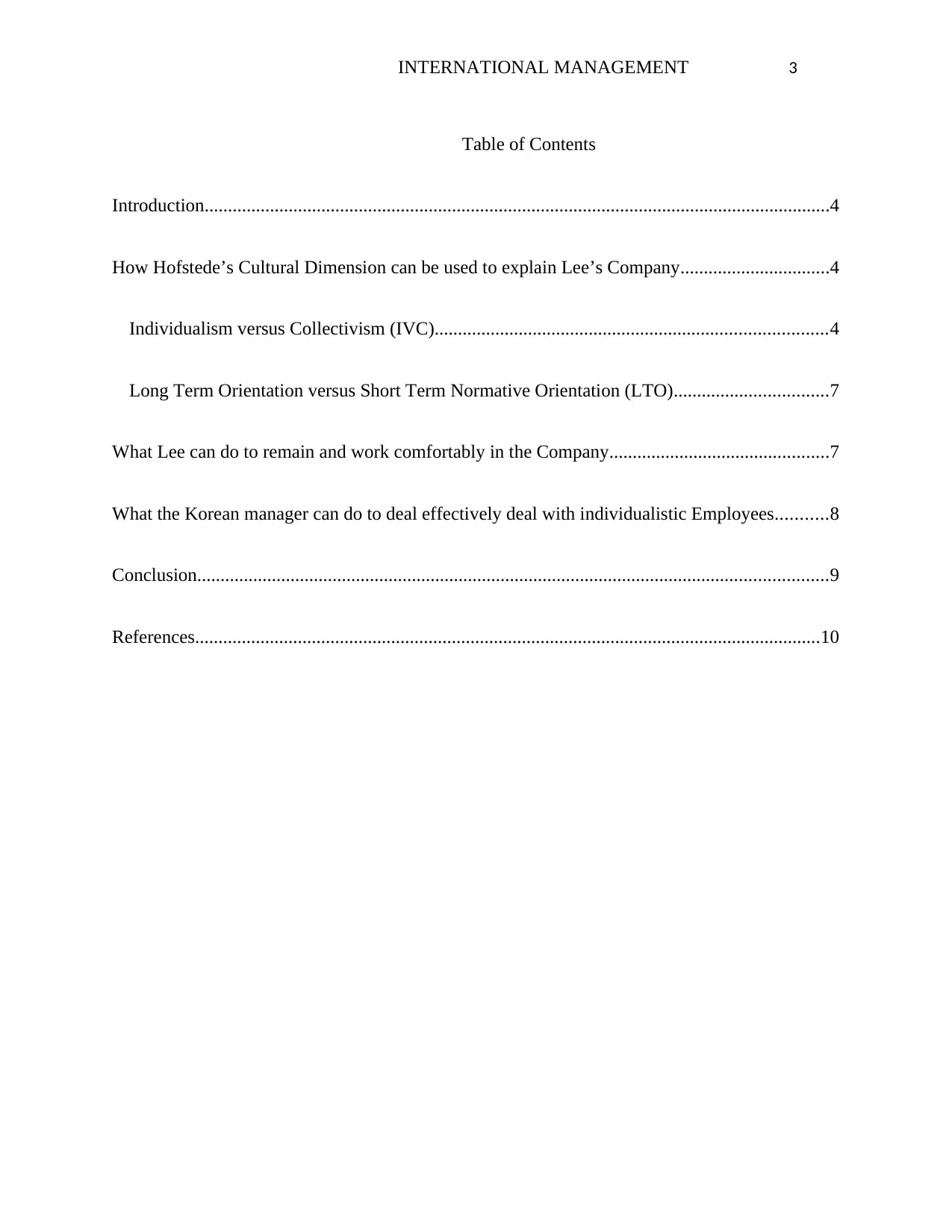
INTERNATIONAL MANAGEMENT 3
Table of Contents
Introduction......................................................................................................................................4
How Hofstede’s Cultural Dimension can be used to explain Lee’s Company................................4
Individualism versus Collectivism (IVC)....................................................................................4
Long Term Orientation versus Short Term Normative Orientation (LTO).................................7
What Lee can do to remain and work comfortably in the Company...............................................7
What the Korean manager can do to deal effectively deal with individualistic Employees...........8
Conclusion.......................................................................................................................................9
References......................................................................................................................................10
Table of Contents
Introduction......................................................................................................................................4
How Hofstede’s Cultural Dimension can be used to explain Lee’s Company................................4
Individualism versus Collectivism (IVC)....................................................................................4
Long Term Orientation versus Short Term Normative Orientation (LTO).................................7
What Lee can do to remain and work comfortably in the Company...............................................7
What the Korean manager can do to deal effectively deal with individualistic Employees...........8
Conclusion.......................................................................................................................................9
References......................................................................................................................................10
⊘ This is a preview!⊘
Do you want full access?
Subscribe today to unlock all pages.

Trusted by 1+ million students worldwide
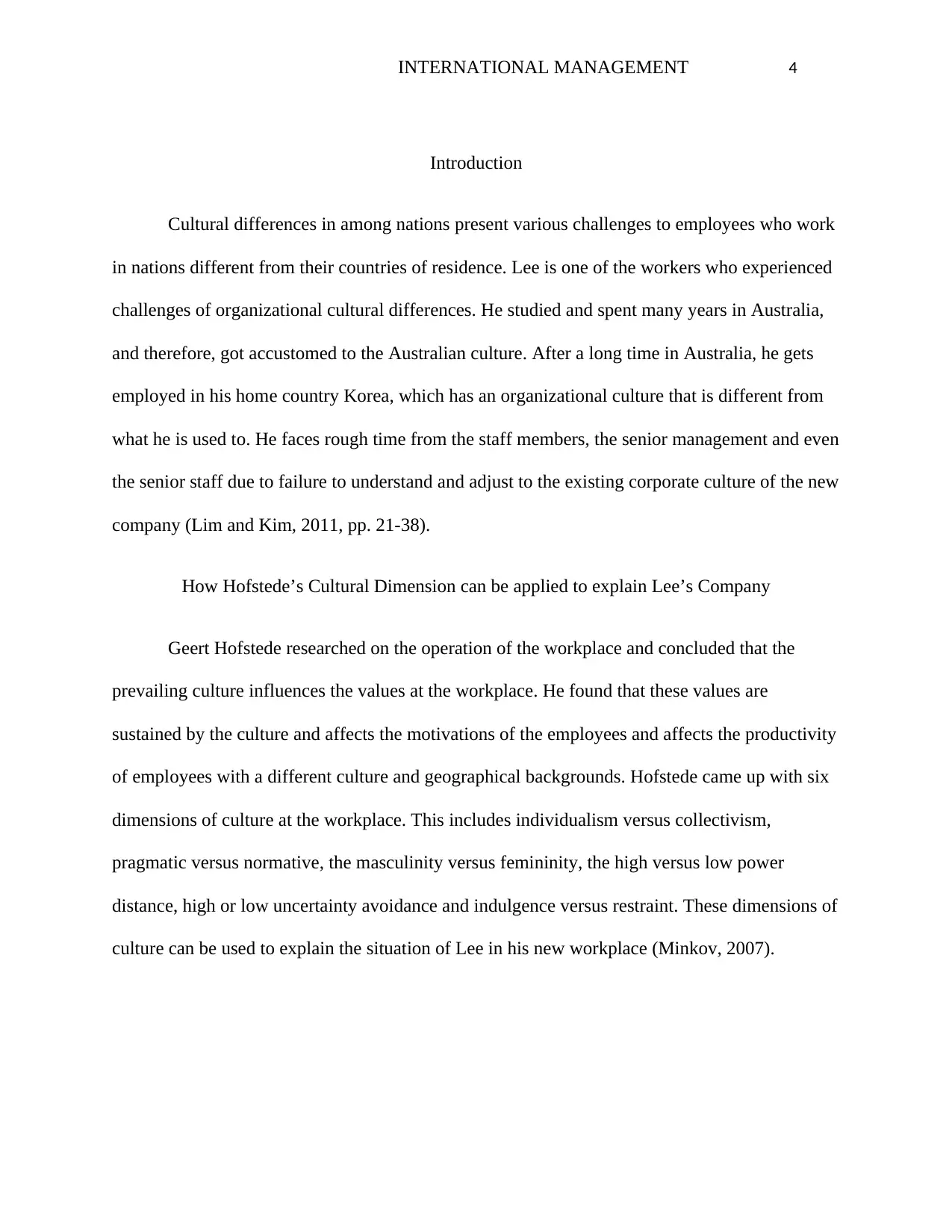
INTERNATIONAL MANAGEMENT 4
Introduction
Cultural differences in among nations present various challenges to employees who work
in nations different from their countries of residence. Lee is one of the workers who experienced
challenges of organizational cultural differences. He studied and spent many years in Australia,
and therefore, got accustomed to the Australian culture. After a long time in Australia, he gets
employed in his home country Korea, which has an organizational culture that is different from
what he is used to. He faces rough time from the staff members, the senior management and even
the senior staff due to failure to understand and adjust to the existing corporate culture of the new
company (Lim and Kim, 2011, pp. 21-38).
How Hofstede’s Cultural Dimension can be applied to explain Lee’s Company
Geert Hofstede researched on the operation of the workplace and concluded that the
prevailing culture influences the values at the workplace. He found that these values are
sustained by the culture and affects the motivations of the employees and affects the productivity
of employees with a different culture and geographical backgrounds. Hofstede came up with six
dimensions of culture at the workplace. This includes individualism versus collectivism,
pragmatic versus normative, the masculinity versus femininity, the high versus low power
distance, high or low uncertainty avoidance and indulgence versus restraint. These dimensions of
culture can be used to explain the situation of Lee in his new workplace (Minkov, 2007).
Introduction
Cultural differences in among nations present various challenges to employees who work
in nations different from their countries of residence. Lee is one of the workers who experienced
challenges of organizational cultural differences. He studied and spent many years in Australia,
and therefore, got accustomed to the Australian culture. After a long time in Australia, he gets
employed in his home country Korea, which has an organizational culture that is different from
what he is used to. He faces rough time from the staff members, the senior management and even
the senior staff due to failure to understand and adjust to the existing corporate culture of the new
company (Lim and Kim, 2011, pp. 21-38).
How Hofstede’s Cultural Dimension can be applied to explain Lee’s Company
Geert Hofstede researched on the operation of the workplace and concluded that the
prevailing culture influences the values at the workplace. He found that these values are
sustained by the culture and affects the motivations of the employees and affects the productivity
of employees with a different culture and geographical backgrounds. Hofstede came up with six
dimensions of culture at the workplace. This includes individualism versus collectivism,
pragmatic versus normative, the masculinity versus femininity, the high versus low power
distance, high or low uncertainty avoidance and indulgence versus restraint. These dimensions of
culture can be used to explain the situation of Lee in his new workplace (Minkov, 2007).
Paraphrase This Document
Need a fresh take? Get an instant paraphrase of this document with our AI Paraphraser
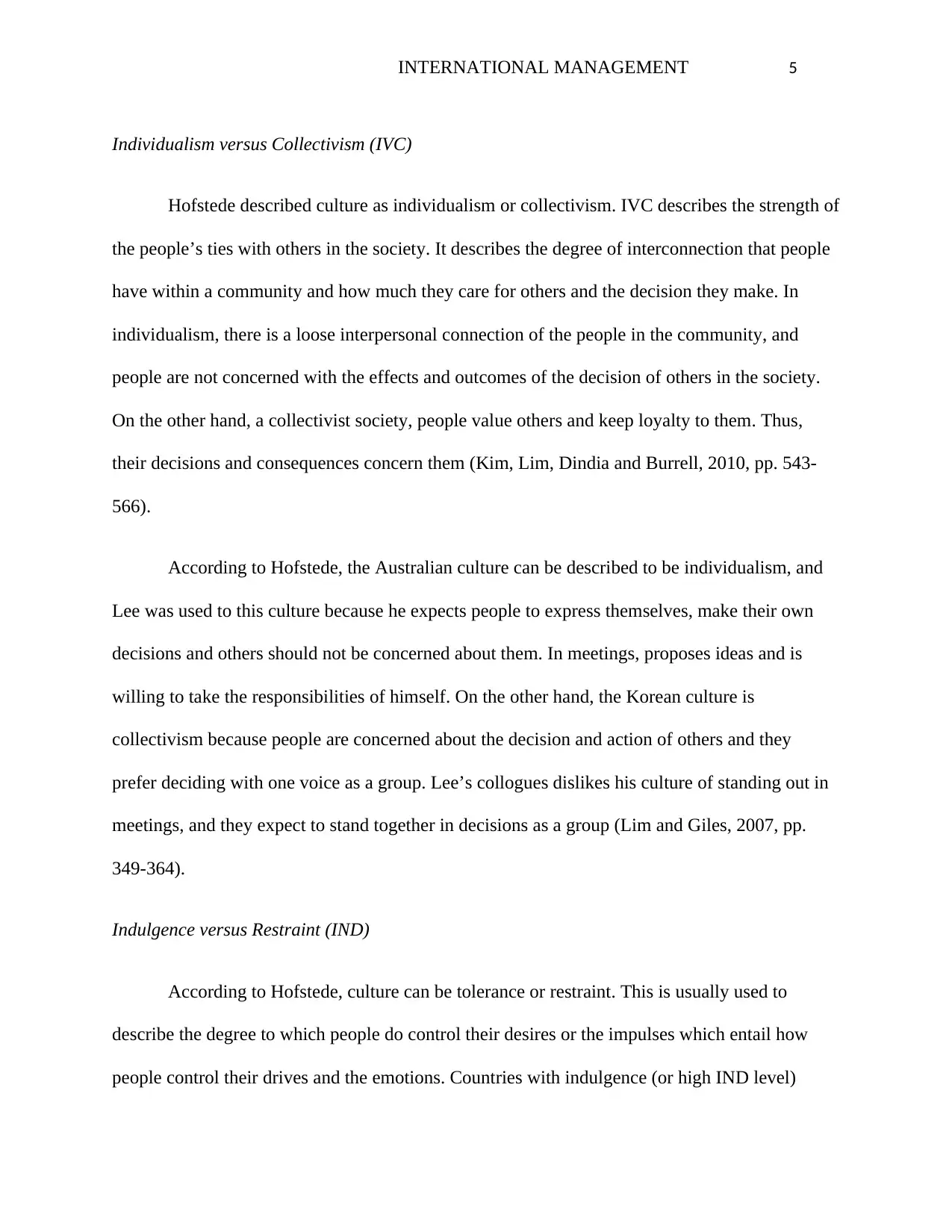
INTERNATIONAL MANAGEMENT 5
Individualism versus Collectivism (IVC)
Hofstede described culture as individualism or collectivism. IVC describes the strength of
the people’s ties with others in the society. It describes the degree of interconnection that people
have within a community and how much they care for others and the decision they make. In
individualism, there is a loose interpersonal connection of the people in the community, and
people are not concerned with the effects and outcomes of the decision of others in the society.
On the other hand, a collectivist society, people value others and keep loyalty to them. Thus,
their decisions and consequences concern them (Kim, Lim, Dindia and Burrell, 2010, pp. 543-
566).
According to Hofstede, the Australian culture can be described to be individualism, and
Lee was used to this culture because he expects people to express themselves, make their own
decisions and others should not be concerned about them. In meetings, proposes ideas and is
willing to take the responsibilities of himself. On the other hand, the Korean culture is
collectivism because people are concerned about the decision and action of others and they
prefer deciding with one voice as a group. Lee’s collogues dislikes his culture of standing out in
meetings, and they expect to stand together in decisions as a group (Lim and Giles, 2007, pp.
349-364).
Indulgence versus Restraint (IND)
According to Hofstede, culture can be tolerance or restraint. This is usually used to
describe the degree to which people do control their desires or the impulses which entail how
people control their drives and the emotions. Countries with indulgence (or high IND level)
Individualism versus Collectivism (IVC)
Hofstede described culture as individualism or collectivism. IVC describes the strength of
the people’s ties with others in the society. It describes the degree of interconnection that people
have within a community and how much they care for others and the decision they make. In
individualism, there is a loose interpersonal connection of the people in the community, and
people are not concerned with the effects and outcomes of the decision of others in the society.
On the other hand, a collectivist society, people value others and keep loyalty to them. Thus,
their decisions and consequences concern them (Kim, Lim, Dindia and Burrell, 2010, pp. 543-
566).
According to Hofstede, the Australian culture can be described to be individualism, and
Lee was used to this culture because he expects people to express themselves, make their own
decisions and others should not be concerned about them. In meetings, proposes ideas and is
willing to take the responsibilities of himself. On the other hand, the Korean culture is
collectivism because people are concerned about the decision and action of others and they
prefer deciding with one voice as a group. Lee’s collogues dislikes his culture of standing out in
meetings, and they expect to stand together in decisions as a group (Lim and Giles, 2007, pp.
349-364).
Indulgence versus Restraint (IND)
According to Hofstede, culture can be tolerance or restraint. This is usually used to
describe the degree to which people do control their desires or the impulses which entail how
people control their drives and the emotions. Countries with indulgence (or high IND level)
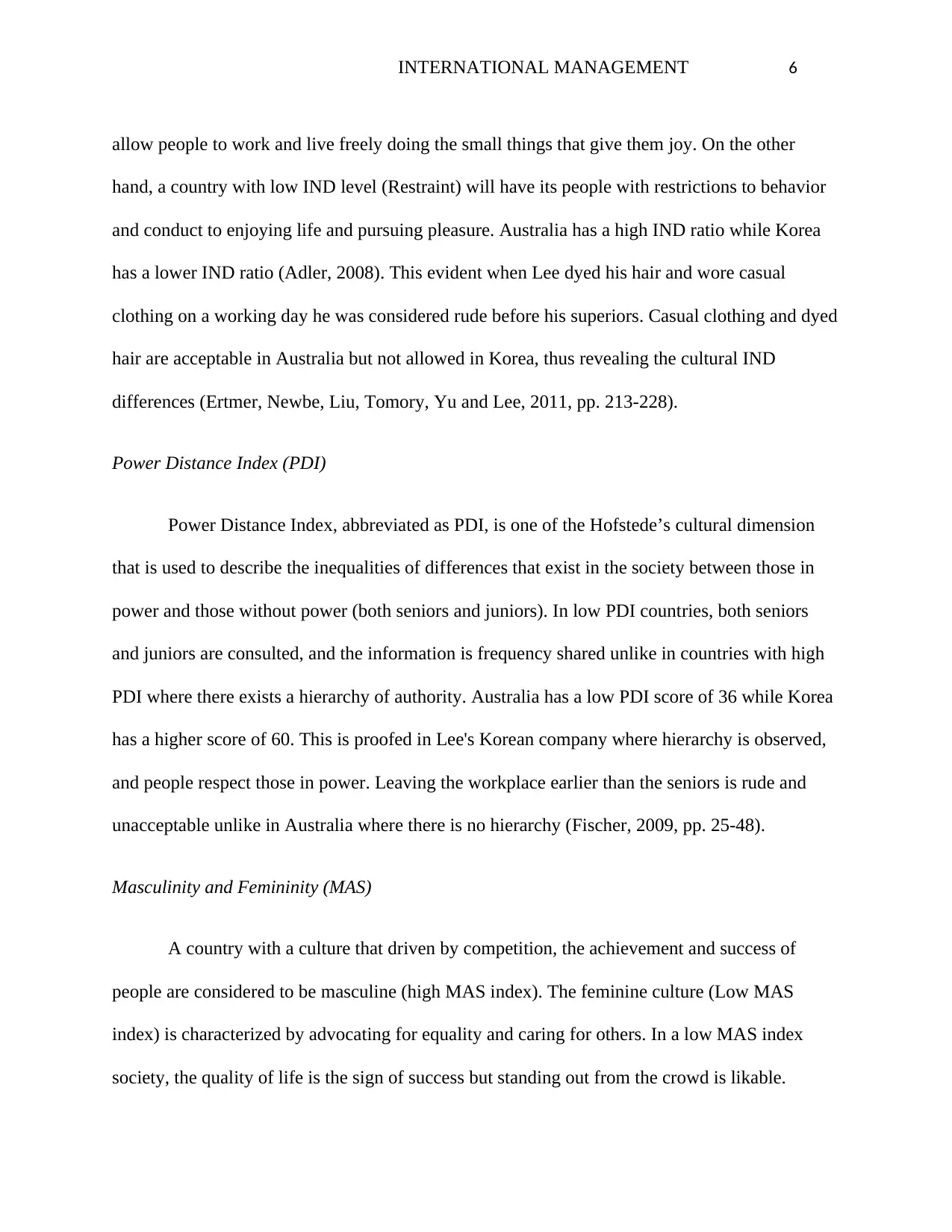
INTERNATIONAL MANAGEMENT 6
allow people to work and live freely doing the small things that give them joy. On the other
hand, a country with low IND level (Restraint) will have its people with restrictions to behavior
and conduct to enjoying life and pursuing pleasure. Australia has a high IND ratio while Korea
has a lower IND ratio (Adler, 2008). This evident when Lee dyed his hair and wore casual
clothing on a working day he was considered rude before his superiors. Casual clothing and dyed
hair are acceptable in Australia but not allowed in Korea, thus revealing the cultural IND
differences (Ertmer, Newbe, Liu, Tomory, Yu and Lee, 2011, pp. 213-228).
Power Distance Index (PDI)
Power Distance Index, abbreviated as PDI, is one of the Hofstede’s cultural dimension
that is used to describe the inequalities of differences that exist in the society between those in
power and those without power (both seniors and juniors). In low PDI countries, both seniors
and juniors are consulted, and the information is frequency shared unlike in countries with high
PDI where there exists a hierarchy of authority. Australia has a low PDI score of 36 while Korea
has a higher score of 60. This is proofed in Lee's Korean company where hierarchy is observed,
and people respect those in power. Leaving the workplace earlier than the seniors is rude and
unacceptable unlike in Australia where there is no hierarchy (Fischer, 2009, pp. 25-48).
Masculinity and Femininity (MAS)
A country with a culture that driven by competition, the achievement and success of
people are considered to be masculine (high MAS index). The feminine culture (Low MAS
index) is characterized by advocating for equality and caring for others. In a low MAS index
society, the quality of life is the sign of success but standing out from the crowd is likable.
allow people to work and live freely doing the small things that give them joy. On the other
hand, a country with low IND level (Restraint) will have its people with restrictions to behavior
and conduct to enjoying life and pursuing pleasure. Australia has a high IND ratio while Korea
has a lower IND ratio (Adler, 2008). This evident when Lee dyed his hair and wore casual
clothing on a working day he was considered rude before his superiors. Casual clothing and dyed
hair are acceptable in Australia but not allowed in Korea, thus revealing the cultural IND
differences (Ertmer, Newbe, Liu, Tomory, Yu and Lee, 2011, pp. 213-228).
Power Distance Index (PDI)
Power Distance Index, abbreviated as PDI, is one of the Hofstede’s cultural dimension
that is used to describe the inequalities of differences that exist in the society between those in
power and those without power (both seniors and juniors). In low PDI countries, both seniors
and juniors are consulted, and the information is frequency shared unlike in countries with high
PDI where there exists a hierarchy of authority. Australia has a low PDI score of 36 while Korea
has a higher score of 60. This is proofed in Lee's Korean company where hierarchy is observed,
and people respect those in power. Leaving the workplace earlier than the seniors is rude and
unacceptable unlike in Australia where there is no hierarchy (Fischer, 2009, pp. 25-48).
Masculinity and Femininity (MAS)
A country with a culture that driven by competition, the achievement and success of
people are considered to be masculine (high MAS index). The feminine culture (Low MAS
index) is characterized by advocating for equality and caring for others. In a low MAS index
society, the quality of life is the sign of success but standing out from the crowd is likable.
⊘ This is a preview!⊘
Do you want full access?
Subscribe today to unlock all pages.

Trusted by 1+ million students worldwide
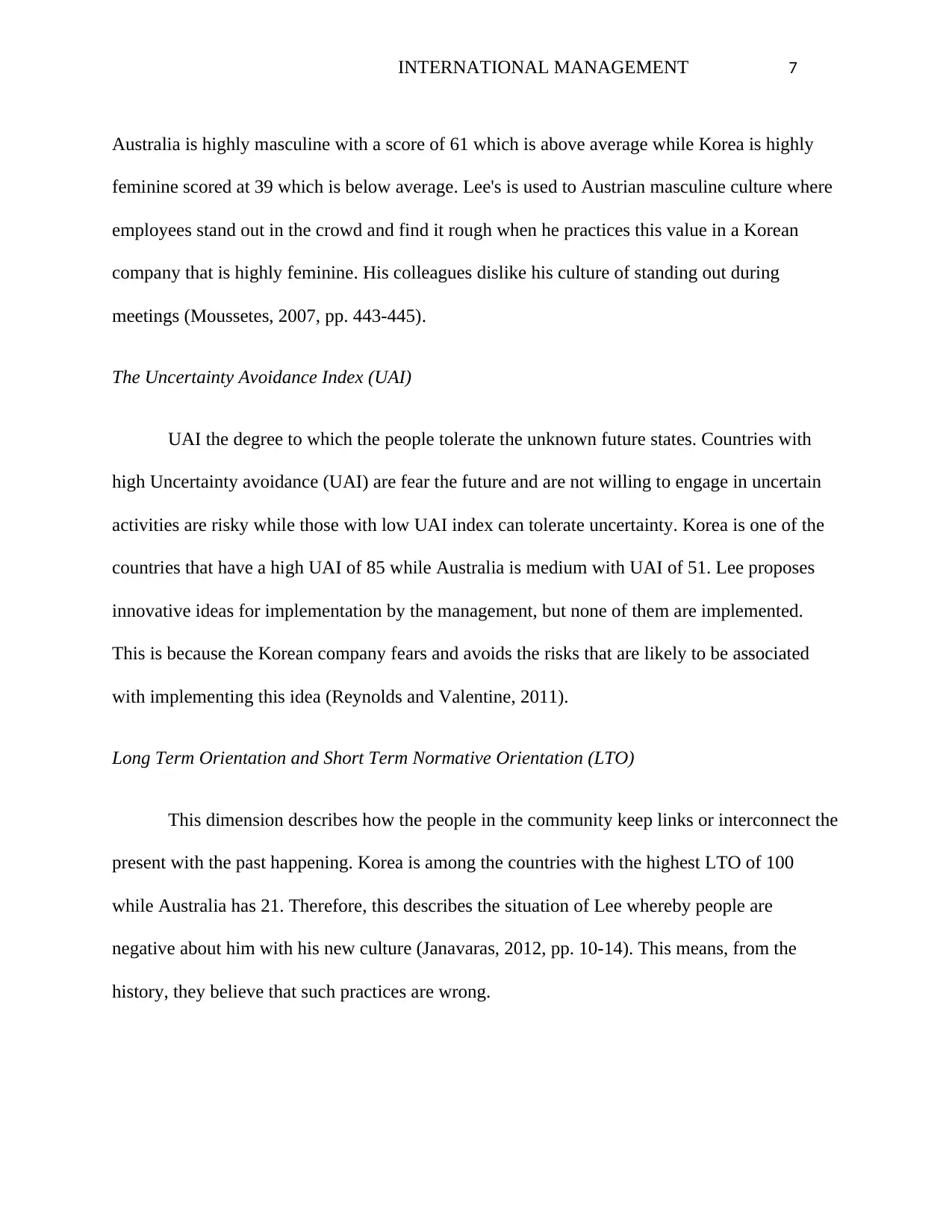
INTERNATIONAL MANAGEMENT 7
Australia is highly masculine with a score of 61 which is above average while Korea is highly
feminine scored at 39 which is below average. Lee's is used to Austrian masculine culture where
employees stand out in the crowd and find it rough when he practices this value in a Korean
company that is highly feminine. His colleagues dislike his culture of standing out during
meetings (Moussetes, 2007, pp. 443-445).
The Uncertainty Avoidance Index (UAI)
UAI the degree to which the people tolerate the unknown future states. Countries with
high Uncertainty avoidance (UAI) are fear the future and are not willing to engage in uncertain
activities are risky while those with low UAI index can tolerate uncertainty. Korea is one of the
countries that have a high UAI of 85 while Australia is medium with UAI of 51. Lee proposes
innovative ideas for implementation by the management, but none of them are implemented.
This is because the Korean company fears and avoids the risks that are likely to be associated
with implementing this idea (Reynolds and Valentine, 2011).
Long Term Orientation and Short Term Normative Orientation (LTO)
This dimension describes how the people in the community keep links or interconnect the
present with the past happening. Korea is among the countries with the highest LTO of 100
while Australia has 21. Therefore, this describes the situation of Lee whereby people are
negative about him with his new culture (Janavaras, 2012, pp. 10-14). This means, from the
history, they believe that such practices are wrong.
Australia is highly masculine with a score of 61 which is above average while Korea is highly
feminine scored at 39 which is below average. Lee's is used to Austrian masculine culture where
employees stand out in the crowd and find it rough when he practices this value in a Korean
company that is highly feminine. His colleagues dislike his culture of standing out during
meetings (Moussetes, 2007, pp. 443-445).
The Uncertainty Avoidance Index (UAI)
UAI the degree to which the people tolerate the unknown future states. Countries with
high Uncertainty avoidance (UAI) are fear the future and are not willing to engage in uncertain
activities are risky while those with low UAI index can tolerate uncertainty. Korea is one of the
countries that have a high UAI of 85 while Australia is medium with UAI of 51. Lee proposes
innovative ideas for implementation by the management, but none of them are implemented.
This is because the Korean company fears and avoids the risks that are likely to be associated
with implementing this idea (Reynolds and Valentine, 2011).
Long Term Orientation and Short Term Normative Orientation (LTO)
This dimension describes how the people in the community keep links or interconnect the
present with the past happening. Korea is among the countries with the highest LTO of 100
while Australia has 21. Therefore, this describes the situation of Lee whereby people are
negative about him with his new culture (Janavaras, 2012, pp. 10-14). This means, from the
history, they believe that such practices are wrong.
Paraphrase This Document
Need a fresh take? Get an instant paraphrase of this document with our AI Paraphraser
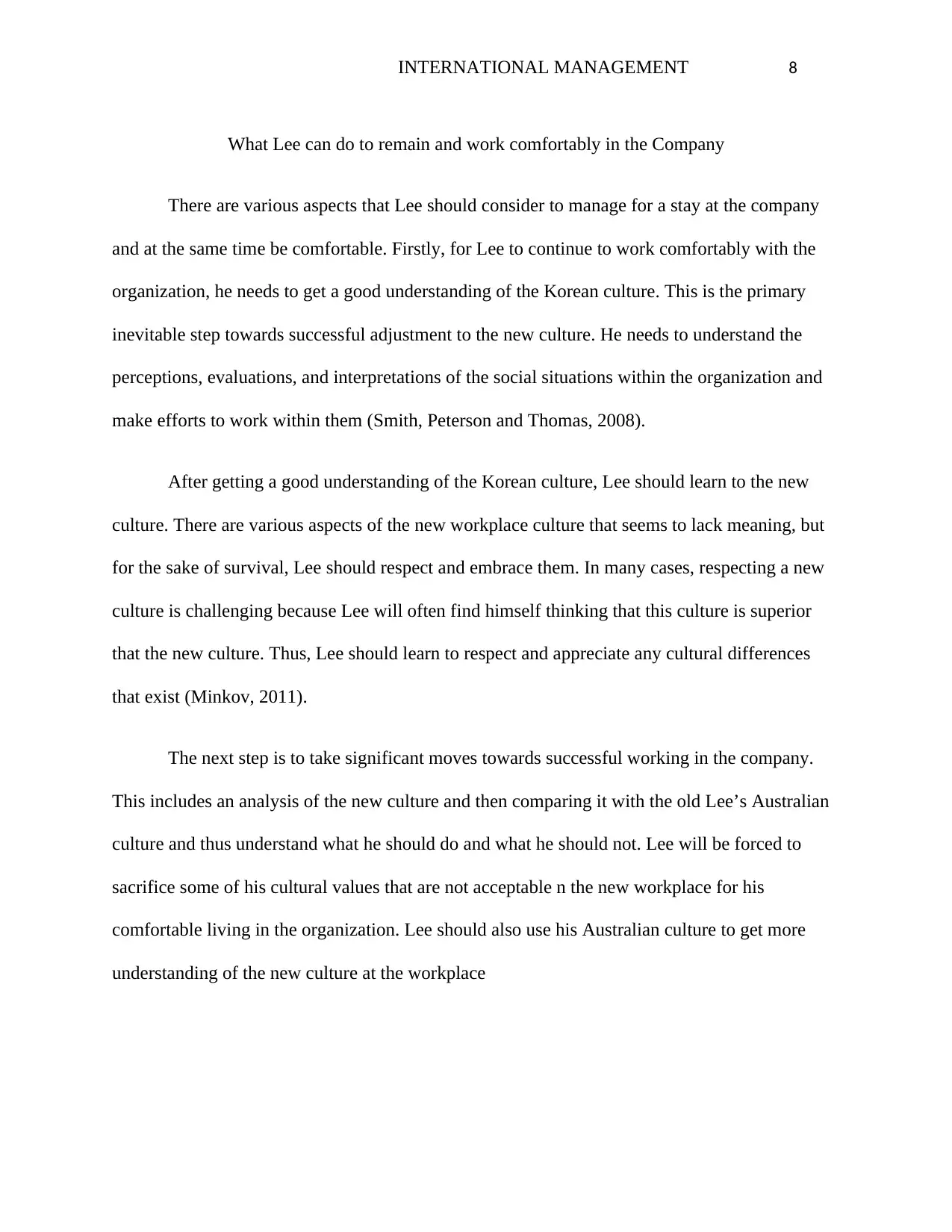
INTERNATIONAL MANAGEMENT 8
What Lee can do to remain and work comfortably in the Company
There are various aspects that Lee should consider to manage for a stay at the company
and at the same time be comfortable. Firstly, for Lee to continue to work comfortably with the
organization, he needs to get a good understanding of the Korean culture. This is the primary
inevitable step towards successful adjustment to the new culture. He needs to understand the
perceptions, evaluations, and interpretations of the social situations within the organization and
make efforts to work within them (Smith, Peterson and Thomas, 2008).
After getting a good understanding of the Korean culture, Lee should learn to the new
culture. There are various aspects of the new workplace culture that seems to lack meaning, but
for the sake of survival, Lee should respect and embrace them. In many cases, respecting a new
culture is challenging because Lee will often find himself thinking that this culture is superior
that the new culture. Thus, Lee should learn to respect and appreciate any cultural differences
that exist (Minkov, 2011).
The next step is to take significant moves towards successful working in the company.
This includes an analysis of the new culture and then comparing it with the old Lee’s Australian
culture and thus understand what he should do and what he should not. Lee will be forced to
sacrifice some of his cultural values that are not acceptable n the new workplace for his
comfortable living in the organization. Lee should also use his Australian culture to get more
understanding of the new culture at the workplace
What Lee can do to remain and work comfortably in the Company
There are various aspects that Lee should consider to manage for a stay at the company
and at the same time be comfortable. Firstly, for Lee to continue to work comfortably with the
organization, he needs to get a good understanding of the Korean culture. This is the primary
inevitable step towards successful adjustment to the new culture. He needs to understand the
perceptions, evaluations, and interpretations of the social situations within the organization and
make efforts to work within them (Smith, Peterson and Thomas, 2008).
After getting a good understanding of the Korean culture, Lee should learn to the new
culture. There are various aspects of the new workplace culture that seems to lack meaning, but
for the sake of survival, Lee should respect and embrace them. In many cases, respecting a new
culture is challenging because Lee will often find himself thinking that this culture is superior
that the new culture. Thus, Lee should learn to respect and appreciate any cultural differences
that exist (Minkov, 2011).
The next step is to take significant moves towards successful working in the company.
This includes an analysis of the new culture and then comparing it with the old Lee’s Australian
culture and thus understand what he should do and what he should not. Lee will be forced to
sacrifice some of his cultural values that are not acceptable n the new workplace for his
comfortable living in the organization. Lee should also use his Australian culture to get more
understanding of the new culture at the workplace
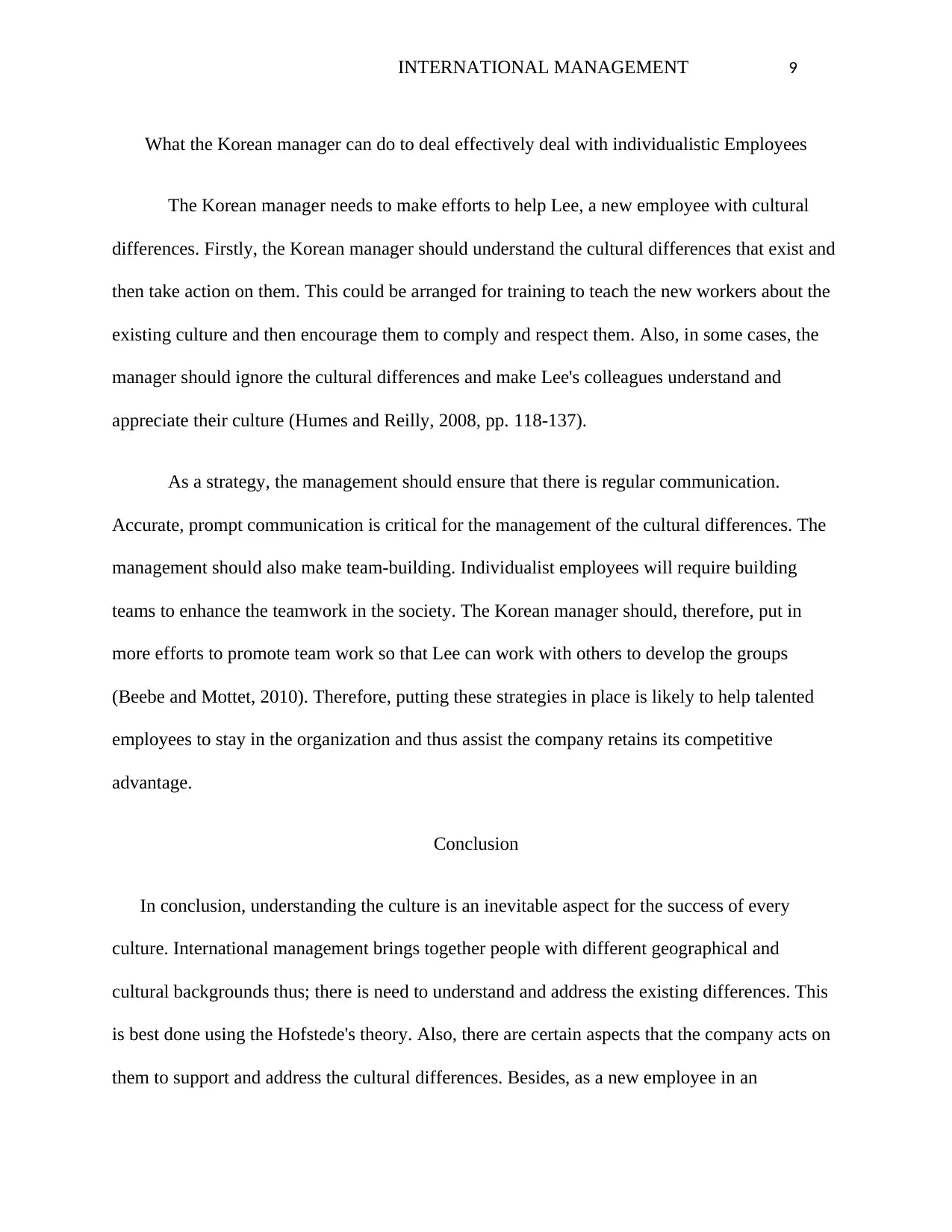
INTERNATIONAL MANAGEMENT 9
What the Korean manager can do to deal effectively deal with individualistic Employees
The Korean manager needs to make efforts to help Lee, a new employee with cultural
differences. Firstly, the Korean manager should understand the cultural differences that exist and
then take action on them. This could be arranged for training to teach the new workers about the
existing culture and then encourage them to comply and respect them. Also, in some cases, the
manager should ignore the cultural differences and make Lee's colleagues understand and
appreciate their culture (Humes and Reilly, 2008, pp. 118-137).
As a strategy, the management should ensure that there is regular communication.
Accurate, prompt communication is critical for the management of the cultural differences. The
management should also make team-building. Individualist employees will require building
teams to enhance the teamwork in the society. The Korean manager should, therefore, put in
more efforts to promote team work so that Lee can work with others to develop the groups
(Beebe and Mottet, 2010). Therefore, putting these strategies in place is likely to help talented
employees to stay in the organization and thus assist the company retains its competitive
advantage.
Conclusion
In conclusion, understanding the culture is an inevitable aspect for the success of every
culture. International management brings together people with different geographical and
cultural backgrounds thus; there is need to understand and address the existing differences. This
is best done using the Hofstede's theory. Also, there are certain aspects that the company acts on
them to support and address the cultural differences. Besides, as a new employee in an
What the Korean manager can do to deal effectively deal with individualistic Employees
The Korean manager needs to make efforts to help Lee, a new employee with cultural
differences. Firstly, the Korean manager should understand the cultural differences that exist and
then take action on them. This could be arranged for training to teach the new workers about the
existing culture and then encourage them to comply and respect them. Also, in some cases, the
manager should ignore the cultural differences and make Lee's colleagues understand and
appreciate their culture (Humes and Reilly, 2008, pp. 118-137).
As a strategy, the management should ensure that there is regular communication.
Accurate, prompt communication is critical for the management of the cultural differences. The
management should also make team-building. Individualist employees will require building
teams to enhance the teamwork in the society. The Korean manager should, therefore, put in
more efforts to promote team work so that Lee can work with others to develop the groups
(Beebe and Mottet, 2010). Therefore, putting these strategies in place is likely to help talented
employees to stay in the organization and thus assist the company retains its competitive
advantage.
Conclusion
In conclusion, understanding the culture is an inevitable aspect for the success of every
culture. International management brings together people with different geographical and
cultural backgrounds thus; there is need to understand and address the existing differences. This
is best done using the Hofstede's theory. Also, there are certain aspects that the company acts on
them to support and address the cultural differences. Besides, as a new employee in an
⊘ This is a preview!⊘
Do you want full access?
Subscribe today to unlock all pages.

Trusted by 1+ million students worldwide
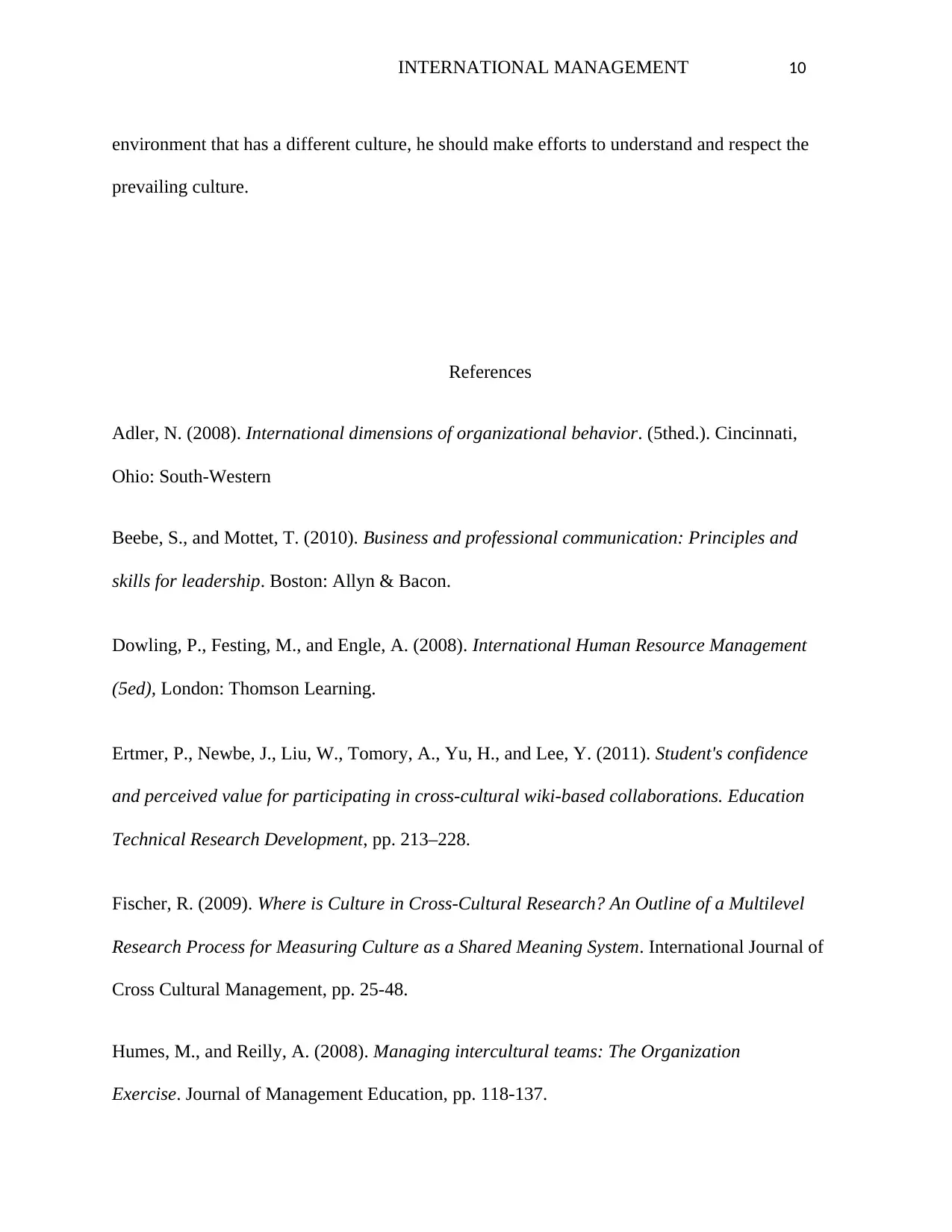
INTERNATIONAL MANAGEMENT 10
environment that has a different culture, he should make efforts to understand and respect the
prevailing culture.
References
Adler, N. (2008). International dimensions of organizational behavior. (5thed.). Cincinnati,
Ohio: South-Western
Beebe, S., and Mottet, T. (2010). Business and professional communication: Principles and
skills for leadership. Boston: Allyn & Bacon.
Dowling, P., Festing, M., and Engle, A. (2008). International Human Resource Management
(5ed), London: Thomson Learning.
Ertmer, P., Newbe, J., Liu, W., Tomory, A., Yu, H., and Lee, Y. (2011). Student's confidence
and perceived value for participating in cross-cultural wiki-based collaborations. Education
Technical Research Development, pp. 213–228.
Fischer, R. (2009). Where is Culture in Cross-Cultural Research? An Outline of a Multilevel
Research Process for Measuring Culture as a Shared Meaning System. International Journal of
Cross Cultural Management, pp. 25-48.
Humes, M., and Reilly, A. (2008). Managing intercultural teams: The Organization
Exercise. Journal of Management Education, pp. 118-137.
environment that has a different culture, he should make efforts to understand and respect the
prevailing culture.
References
Adler, N. (2008). International dimensions of organizational behavior. (5thed.). Cincinnati,
Ohio: South-Western
Beebe, S., and Mottet, T. (2010). Business and professional communication: Principles and
skills for leadership. Boston: Allyn & Bacon.
Dowling, P., Festing, M., and Engle, A. (2008). International Human Resource Management
(5ed), London: Thomson Learning.
Ertmer, P., Newbe, J., Liu, W., Tomory, A., Yu, H., and Lee, Y. (2011). Student's confidence
and perceived value for participating in cross-cultural wiki-based collaborations. Education
Technical Research Development, pp. 213–228.
Fischer, R. (2009). Where is Culture in Cross-Cultural Research? An Outline of a Multilevel
Research Process for Measuring Culture as a Shared Meaning System. International Journal of
Cross Cultural Management, pp. 25-48.
Humes, M., and Reilly, A. (2008). Managing intercultural teams: The Organization
Exercise. Journal of Management Education, pp. 118-137.
Paraphrase This Document
Need a fresh take? Get an instant paraphrase of this document with our AI Paraphraser
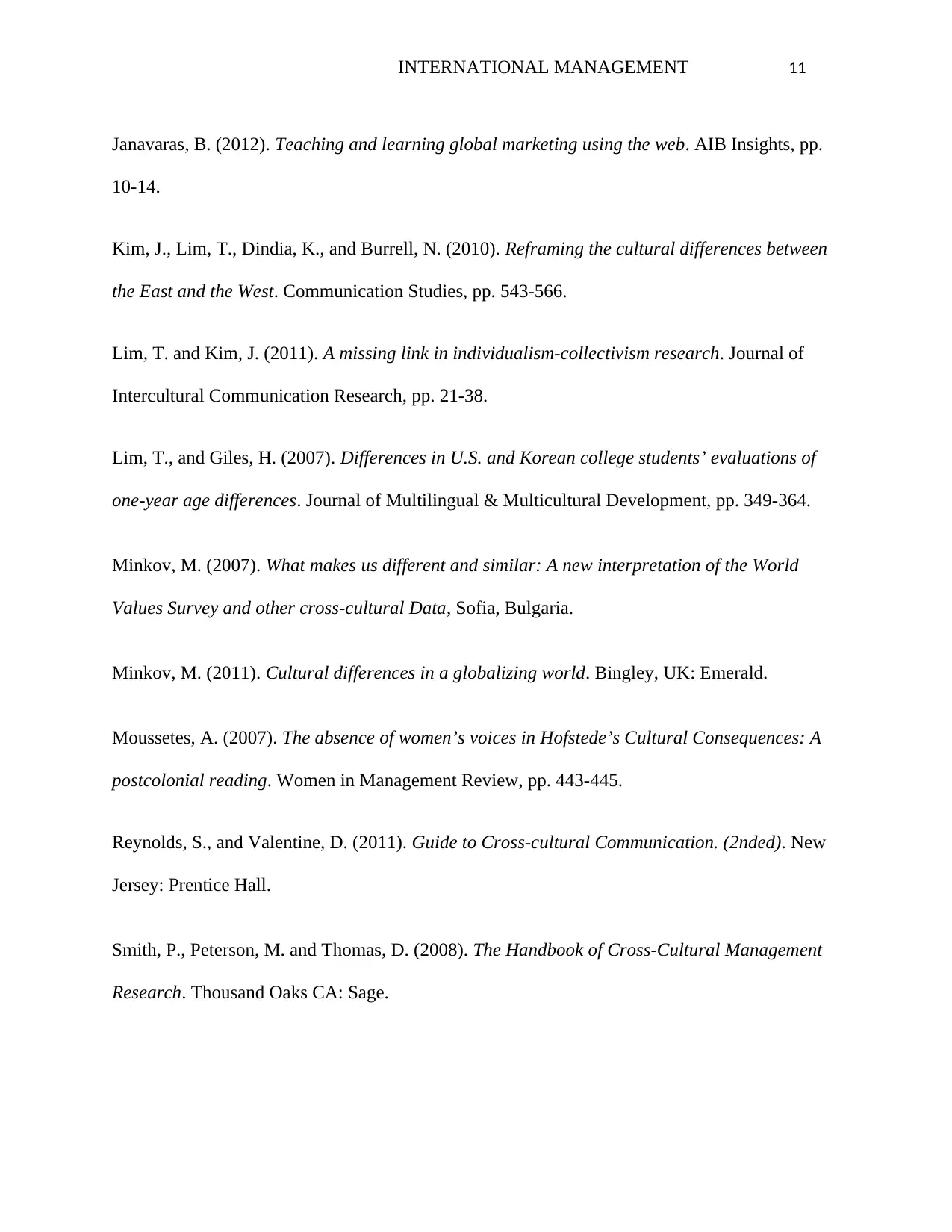
INTERNATIONAL MANAGEMENT 11
Janavaras, B. (2012). Teaching and learning global marketing using the web. AIB Insights, pp.
10-14.
Kim, J., Lim, T., Dindia, K., and Burrell, N. (2010). Reframing the cultural differences between
the East and the West. Communication Studies, pp. 543-566.
Lim, T. and Kim, J. (2011). A missing link in individualism-collectivism research. Journal of
Intercultural Communication Research, pp. 21-38.
Lim, T., and Giles, H. (2007). Differences in U.S. and Korean college students’ evaluations of
one-year age differences. Journal of Multilingual & Multicultural Development, pp. 349-364.
Minkov, M. (2007). What makes us different and similar: A new interpretation of the World
Values Survey and other cross-cultural Data, Sofia, Bulgaria.
Minkov, M. (2011). Cultural differences in a globalizing world. Bingley, UK: Emerald.
Moussetes, A. (2007). The absence of women’s voices in Hofstede’s Cultural Consequences: A
postcolonial reading. Women in Management Review, pp. 443-445.
Reynolds, S., and Valentine, D. (2011). Guide to Cross-cultural Communication. (2nded). New
Jersey: Prentice Hall.
Smith, P., Peterson, M. and Thomas, D. (2008). The Handbook of Cross-Cultural Management
Research. Thousand Oaks CA: Sage.
Janavaras, B. (2012). Teaching and learning global marketing using the web. AIB Insights, pp.
10-14.
Kim, J., Lim, T., Dindia, K., and Burrell, N. (2010). Reframing the cultural differences between
the East and the West. Communication Studies, pp. 543-566.
Lim, T. and Kim, J. (2011). A missing link in individualism-collectivism research. Journal of
Intercultural Communication Research, pp. 21-38.
Lim, T., and Giles, H. (2007). Differences in U.S. and Korean college students’ evaluations of
one-year age differences. Journal of Multilingual & Multicultural Development, pp. 349-364.
Minkov, M. (2007). What makes us different and similar: A new interpretation of the World
Values Survey and other cross-cultural Data, Sofia, Bulgaria.
Minkov, M. (2011). Cultural differences in a globalizing world. Bingley, UK: Emerald.
Moussetes, A. (2007). The absence of women’s voices in Hofstede’s Cultural Consequences: A
postcolonial reading. Women in Management Review, pp. 443-445.
Reynolds, S., and Valentine, D. (2011). Guide to Cross-cultural Communication. (2nded). New
Jersey: Prentice Hall.
Smith, P., Peterson, M. and Thomas, D. (2008). The Handbook of Cross-Cultural Management
Research. Thousand Oaks CA: Sage.
1 out of 11
Related Documents
Your All-in-One AI-Powered Toolkit for Academic Success.
+13062052269
info@desklib.com
Available 24*7 on WhatsApp / Email
![[object Object]](/_next/static/media/star-bottom.7253800d.svg)
Unlock your academic potential
Copyright © 2020–2025 A2Z Services. All Rights Reserved. Developed and managed by ZUCOL.





